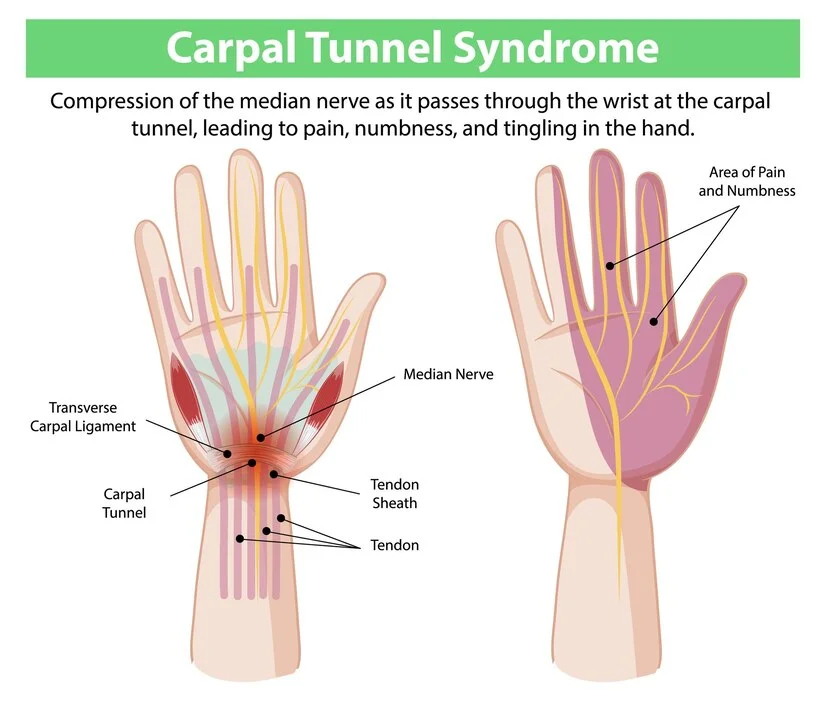Understanding Carpal Tunnel Syndrome: Causes, Symptoms, and Treatment

Carpal Tunnel Syndrome (CTS) is a widely known but rarely well-understood malady suffered by millions of people worldwide. CTS, which is characterised by pain, numbness, and tingling in the hand and wrist, is brought on by pinching of the median nerve, one of the main nerves that regulate hand movement, in the carpal tunnel, a small opening in the wrist.
Prompt diagnosis and treatment are important to avoid permanent nerve damage and preserve hand function. Although CTS is commonly thought of as the result of repetitive hand movements, like typing or working on an assembly line, it can also be caused by a variety of underlying medical conditions, including diabetes, arthritis, and hormonal changes.
This guide looks at the causes, symptoms, and treatment options for Carpal Tunnel Syndrome and provides practical tips on preventing and managing the condition.
What is Carpal Tunnel Syndrome?
Nerve compression in the hand and wrist is known as carpal tunnel syndrome (CTS). At the base of the hand lies a short, stiff corridor made up of ligaments and bones called the carpal tunnel. The tunnel contains the median nerve, which innervates the thumb, index, middle fingers, and half of the ring finger, and also controls the movement of the small muscles in the hand.
When the tunnel becomes narrowed from swelling or inflammation, the median nerve gets squeezed, resulting in CTS’s telltale symptoms: tingling, numbness, weakness, and pain. Muscle atrophy and irreversible nerve damage could result from ongoing compression if treatment is not received.
Causes and Risk Factors
Although excessive hand use has been the most commonly cited cause of CTS, several other factors have been associated with the development of CTS:
Repetitive Hand Use
- Obligations or activities with extended typing, writing, or use of vibrating tools (i.e., construction work) that press on the median nerve.
2. Wrist Injuries
- A carpal tunnel can become deformed by fractures or sprains that cause nerve compression.
3. Medical Conditions
- Diabetes predisposes one to be more susceptible to forearm nerve compression.
- Rheumatoid arthritis: Inflammation of the wrist.
- Thyroid diseases can cause water retention, putting pressure on nerves.
4. Hormonal Changes
- Pregnancy, menopause, and hormone dysfunction are common causes of wrist swelling.
5. Genetic Factors
- Not everyone is so lucky; however, some folks just have less room in their carpal tunnel–also known as a “small tunnel”.
Common Symptoms
Symptoms of CTS often develop slowly and can include:
- The thumb, index, and middle fingers are particularly affected by numbness and tingling.
- Aching or throbbing pain – All the way from the wrist to the elbow.
- Weakness – Problems picking up objects, speaking, or performing other small movements of the body.
- Discomfort at night – People often find themselves waking up with a need to “shake out” their hands.
Symptoms can progress, causing chronic pain and loss of hand function if left untreated.
Diagnosis
It’s important to have an accurate diagnosis to help eliminate neck conditions that often present with similar symptoms, including arthritis or cervical radiculopathy.
1. Physical Examinations include:
- Tapping the wrist to see if tingling results.
- Wrist flexion is used in Phalen’s test to produce symptoms.
2. Nerve Conduction Studies (NCS) & Electromyography (EMG)
- By measuring the median nerve’s electrical activity, these procedures confirm the extent of compression.
3. Medical History Review
Evaluating occupational risk, injury, and pre-existing health problems is useful to guide management.
Treatment Options
Non-Surgical Treatments
- Wrist splints – Nighttime use to allow the wrist to remain neutral.
- Non-steroidal anti-inflammatory drugs (NSAIDs) – This will help reduce the swelling as well as the pain.
- Steroid injections – Relieve symptoms for the short term by reducing inflammation.
- Physical therapy – Exercises having to do with stretching and strengthening help stretch muscles.
Surgical Treatments
Carpal tunnel release surgery may be recommended if conservative methods do not work. In this outpatient procedure, the surgeon makes a small incision in the palm, then cuts the transverse carpal ligament to free the median nerve.
- Healing time: Most patients get back to their regular routines in a few weeks.
- Success rate: More than 90% of patients’ symptoms will be relieved.
Preventive Measures
Avoiding CTS is a matter of making a few lifestyle changes:
- Ergonomic workstations – Keep your wrists straight when typing and use a cushioned mouse pad.
- Frequent breaks – Stretch hands and wrists every 30 minutes.
- Exercises for the hands – Light stretches in all directions help to promote blood flow and suppleness.
- Treat the underlying conditions – You can treat diabetes, arthritis, and thyroid conditions with medical advice.
Living with CTS
For those managing chronic CTS:
- Adapt Tools – Use ergonomic keyboards or voice-to-text software.
- Avoid Aggravating Activities – Modify tasks that worsen symptoms.
- Follow-Up Care – Regular check-ups ensure long-term nerve health.
When to See a Doctor
Consult a doctor if you have:
- Numbness or weakness that lingers.
- General weakness: Difficulty doing things that you could previously do easily.
- Symptoms are getting worse even after home treatment.
Intervention from an early stage can stop the destruction from becoming irreversible.
Conclusion
Carpal Tunnel Syndrome is a curable disorder; early intervention is a must. Regardless of lifestyle alterations, physiotherapy, or surgery, there are treatments that work.
At Chase Lodge Hospital, our experts will deliver individualised treatment to get you back to living pain-free. If you think you may have CTS, then don’t wait – set up an appointment today.
Do something good for your hand health before your symptoms worsen.